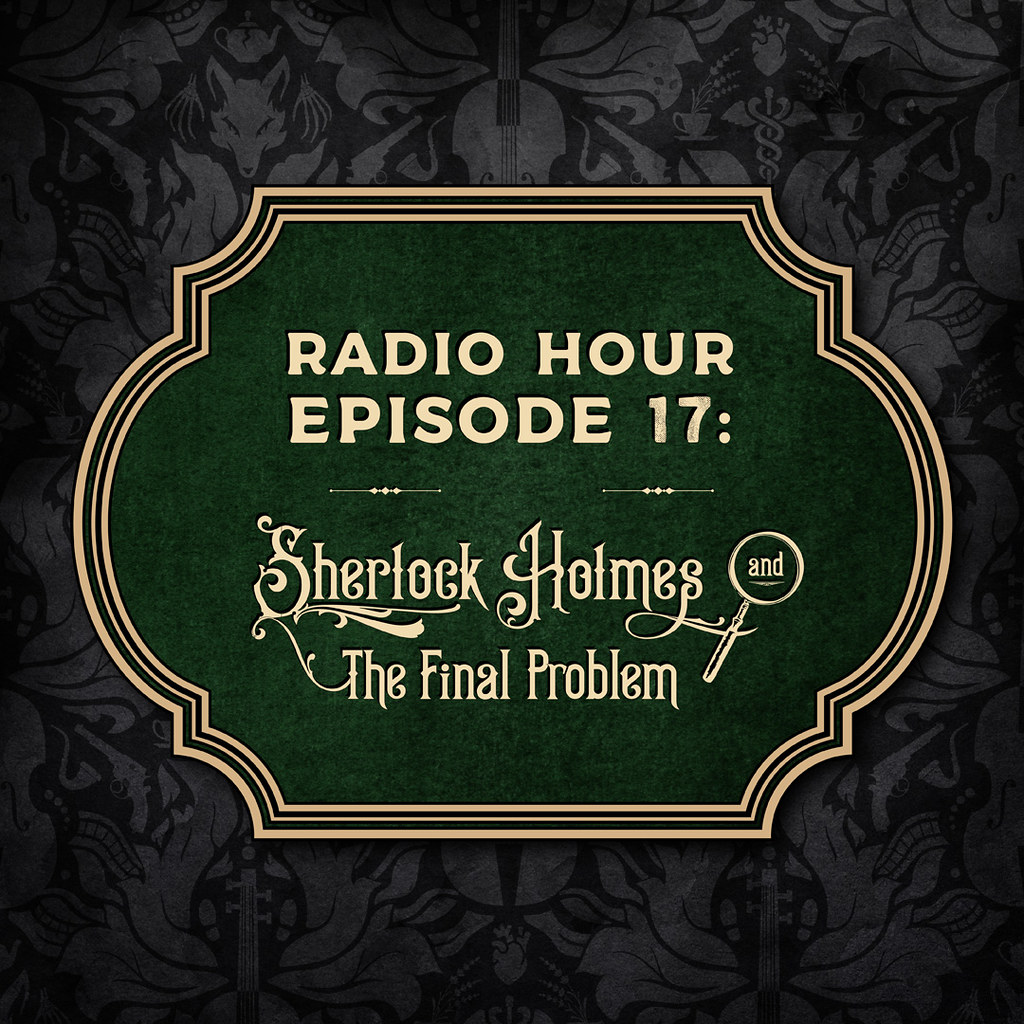Welcome to the 17th episode of the Radio Hour series of Plan-B Theatre’s Radio Hour series, produced with KUER-FM’s RadioWest, hosted by Doug Fabrizio on KUER-FM (90.1). For the first time since 2014, a Radio Hour episode will have a live audience for its premiere. The episode, written by veteran Radio Hour scribe Matthew Ivan Bennett, is an adaptation of Sir Arthur Conan Doyle’s The Final Problem, one of the most famous short stories in The Sherlock Holmes series. This production has two live performances today in the Jeanné Wagner Theatre of the Rose Wagner Center for Performing Arts. The second one will be later today at 7 p.m. Both performances will be broadcast on RadioWest, KUER-FM 90.1.
For a preview of Sherlock Holmes and The Final Problem, see The Utah Review feature.
10:55 a.m.
Writing his 13th episode for the Radio Hour series, Matthew Ivan Bennett decided to adapt Sir Arthur Conan Doyle’s The Final Problem short story, in which the famed fictional detective is killed. The 1893 story sent Sherlock Holmes fans into shock and mourning, with many following Victorian Era conventions by wearing black armbands and putting up black crepe paper. Doyle had hoped that by killing off Holmes, he could finally gain recognition for his other work. The pushback was so strong that eventually Doyle had to ‘resurrect’ Holmes.
In The Final Problem, Bennett gives us Dr. Watson, who always has been Holmes’ most trusted friend, as a woman. With this significant change, Bennett achieves what Doyle could not accomplish. Bennett teases out a deeper emotional context about a towering intellectual paragon of logic whom everyone saw as a great man. Indeed, The Final Problem opens the doors to envisioning Holmes as a decent man capable of admitting just how much he admired Watson, not just professionally but also in a personally intimate way.
This is the second time that Plan-B has adapted a Holmes story for Radio Hour. In 2012, in a holiday season premiere with a live audience, the seventh Radio Hour episode was based on the 1892 short story, The Adventure of the Blue Carbuncle, the only in the Holmes series that was set in the Christmas season.
Joining director Cheryl Ann Cluff for the live production are musician and composer David Evanoff, Emilio Casillas (lighting designer). Daniel Charon (projections designer), Joe Killian (sound designer and eFoley), Brian Albers and Jay Clark (sound engineers) and Bridgette Lehman (stage manager).
11 a.m.
This is the sixth Radio Hour episode to premiere in front of a live audience outside of KUER-FM studios. The first thing audience members will hear is the top-of-the-hour news summary from NPR before the show begins. The story is in three parts, to accommodate all of the usual station breaks.
Take note of the stunning projected visuals, courtesy of Daniel Charon, who is the artistic director for the Ririe-Woodbury Dance Company, one of the six residential organizations in The Rose Wagner Center for Performing Arts. A voracious reader with a healthy appetite for science fiction as well, Charon is well-known for his incorporation of multimedia elements into his choreography, which emphasizes the kinetics of dance theater.
Three actors handle the story’s 11 characters. The cast includes Jay Perry (Moriarty and all minor character roles), who has appeared in every Radio Hour production); Isabella Reeder (Watson), who is making her fourth Radio Hour appearance, and Doug Fabrizio (Holmes), the host of RadioWest who is making his sixth appearance as an actor and the second as the famous detective. Perry handles the minor characters, which include Hansom Cabman, Brougham Driver, Porter, Old Italian Priest (AKA Holmes), Maître D’, Mountain Guide, Steiler and Swiss Lad. Perry is a smooth master at Radio Hour and can switch voices with barely a skipped beat.
11:07 a.m.
In the introduction, which reads like an epilog, Watson speaks to the Radio Hour audience:
I take up my pen today with a heavy heart. For I had intended to stop writing about my friend, to say nothing of the tragedy. The very thought of him now rips me in half. But my hand has been forced by libel in the press, and so it passes to me to record what really happened at Reichenbach Falls between Professor Moriarty and Sherlock Holmes.
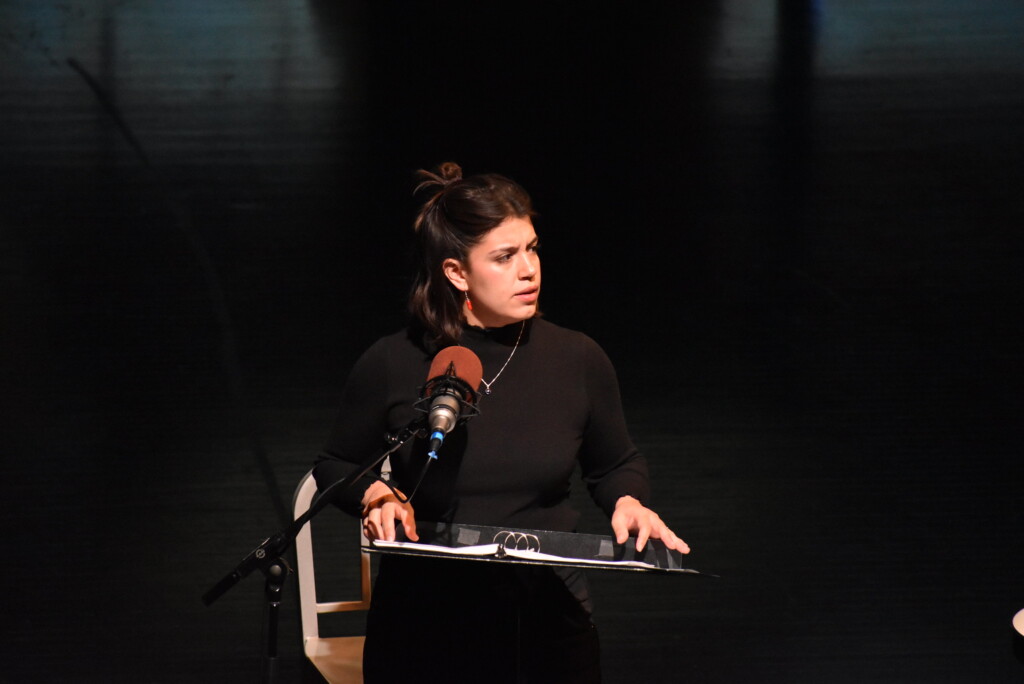
Photo Credit: Sharah Meservy.
11:09 a.m.
Scene 1 puts us in the story with Holmes and Watson. Holmes is spooked and wanting a match from Watson, who says she will not abet his smoking habit. Watson is surprised to hear that Holmes is running for his life. He tells her: “I thought that was clear. Surely you can the read the signs: my skin is flushed; my pupils, dilated; my mouth, dry as a bone.”
Here, we get the first significant signs of how Bennett frames Watson as a female character. She attempts to correct Holmes that her husband is not “Mr. Watson,” but Holmes insists that he will never call him by his surname, even though Watson has taken. It is something Holmes considers silly for Watson to have done.
11:11 a.m.
We hear Moriarty’s name for the first time. Holmes gives Watson, who has never heard of him, the background about his arch-nemesis: “Ay, and there’s the genius of him. The man pervades London and no one has heard of him, Watson. I could almost believe that I have dreamt this kingpin. That is what puts him on a pinnacle. I tell you, though, if I could beat him, if I could free society of him, I would come to my pinnacle. And be content with nothing but my chemical research.
Holmes is impassioned: “in cases of forgery, robbery, murder, I have felt the presence of this force, deduced its action in many crimes; for years I have endeavored to unravel the veil that shrouded it, and at last the time came when I seized my thread and pulled until… (growls) I am so close. The last steps have been taken; three days more, I might close the case.”

Photo Credit: Sharah Meservy.
11:16 a.m.
Scene 2 brings us to a flashback encounter between Holmes and Moriarity.
Holmes has flummoxed Moriarty to the point that the evil professor believes is now untenable. Bennett crafts a nice dialogue of intellectual sparring between the good genius and his evil counterpart. Moriarty recounts Holmes’ gambit: “You hope to cage me. But I tell you I will never be caged. You hope to kill me, short of locking me up, but your moment will not come. If you are blessed enough by fortune to visit havoc upon me, rest assured I shall repay the blessing.”
The last bit captures Bennett’s skill at punctuating such dialogue exchanges in his Radio Hour writing:
Holmes: “Could I be sure of your chains, Moriarty, in the public interest I would welcome my curtain call.”
Moriarty, snarling: “I can promise curtains, but not chains.”
11:17 a.m.
Bennett has set the script with plenty of fast scene transitions. There are 14 scenes in the 48-minute play. Scene 3 brings us back to Watson and Holmes. She can’t understand why Holmes did not shoot Moriarty in the leg. Holmes tells her he felt paralyzed: “His way of speaking leaves a conviction of sincerity a bully could not produce.”
11:18 a.m.
Even in adaptation, Bennett highlights the familiar details that have endeared fans to Sherlock Holmes. One feature is the detective’s unfailing attention to the smallest of details.
Holmes observes that an indentation on Watson’s middle finger on her right hand is less pronounced than usual, which he assumes means she has been taking fewer notes on her patients. Watson confirms this. Likewise, Holmes notes that Watson’s neighbor is so accommodating that she has given the doctor a plate of roast chicken. At first, Watson tries to disprove Holmes’ observation but then asks him how he knew about the chicken. Holmes tells her that he knew because of a grease stain on her blouse and that he could smell roasted chicken on her breath.
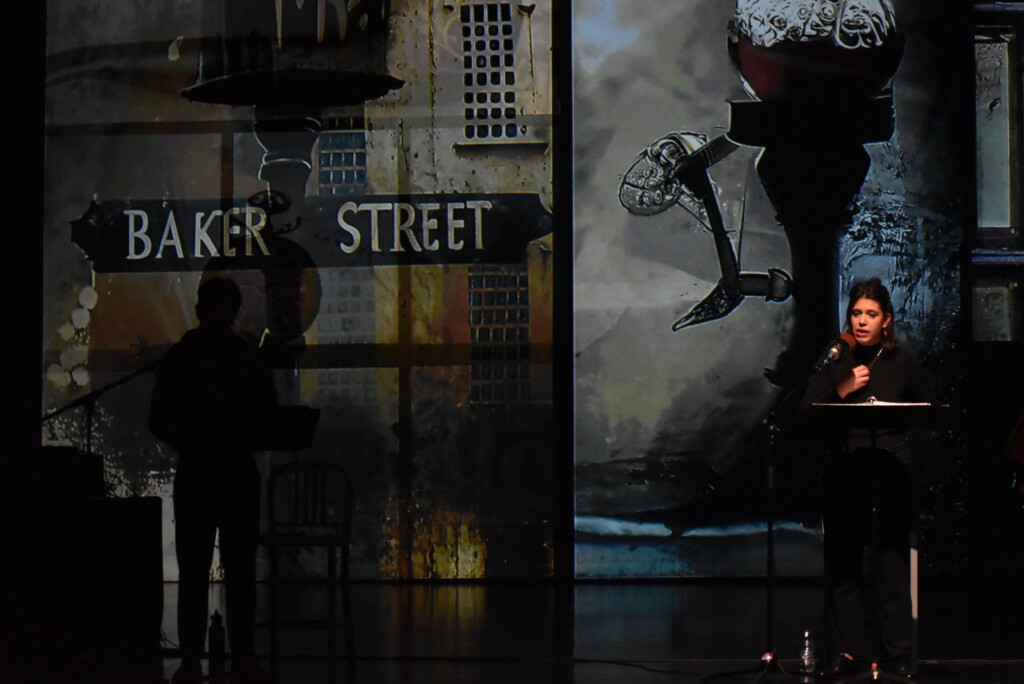
Photo Credit: Sharah Meservy.
11:19 a.m.
Holmes puts the bottom line on the most consequential case of his career. He tells Watson: “I took the liberty of scribbling some instructions for you, and I beg you, Joanna, obey them to the letter. For we are now playing a game against the worst rogue I have ever met.”
11:21 a.m.
Back after the station break, Radio Hour resumes with the second part of the episode. Scene 4 showcases Bennett’s decision to cast Watson as a woman, especially in her dealings with a brougham driver and a railway station porter. And, yes, there is historical grounding for the appearance of a woman doctor in Victorian England. Elizabeth Garrett Anderson in 1865 became the first woman in Britain to be fully qualified to practice medicine as a physician and surgeon.

11:22 a.m.
Watson is fretting about why Holmes had not yet appeared at the station. Meanwhile, she went back and forth with the porter who refused to assist an elderly Italian priest.
11:24 a.m.
Watson discovers that Holmes was disguised as the Italian priest, in order to throw Moriarty off the trail. But, then Watson spots the “monk of a trickster god.” Watson speaks to the audience: “He peered at me with cold metallic curiosity. Moriarty was no dream in the mind of Sherlock Holmes. He was only too real. I willed the train to gather speed. We shot clear of the station.”
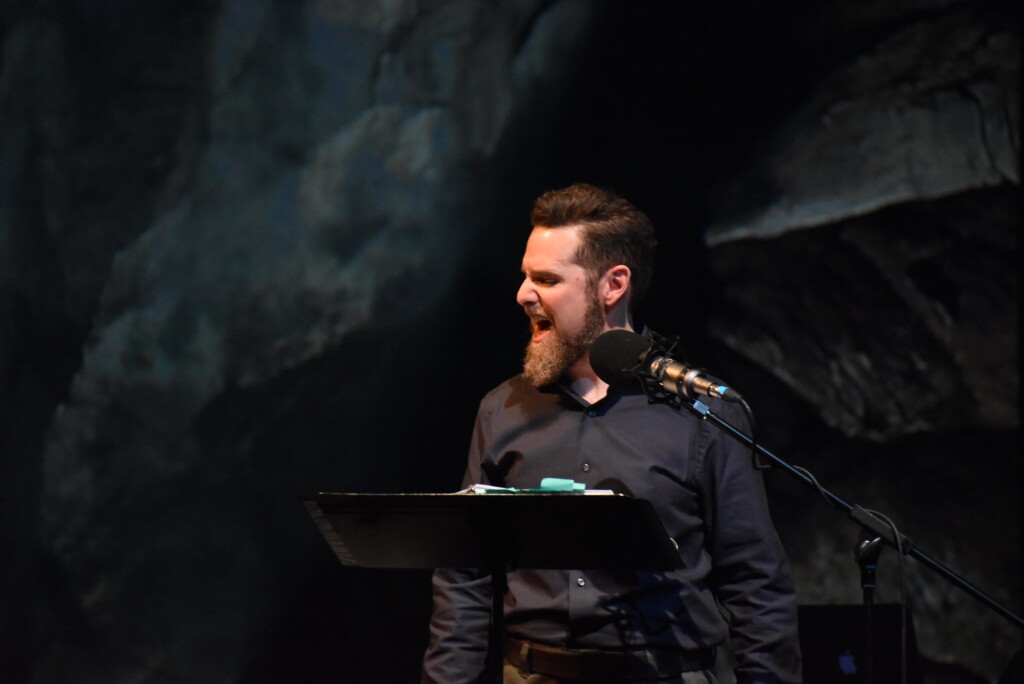
Photo Credit: Sharah Meservy.
11:26 a.m.
Watson urges Holmes to have the police pick up Moriarty at the harbor. Holmes rejects the suggestion, believing it would wreck the months of work he has put into the case.
11:31 a.m.
Bennett’s script has picked up the pace significantly. Watson and Holmes are now in Canterbury, in Scene 5. Realizing there is no time for lunch, Watson offers Holmes raisin biscuits, adding that one needs fiber in their diet. Yours truly can appreciate this line from Holmes: “My work requires concentrated sugar. I eat for the brain, not the intestines. I’m going to starve.”
11:32 a.m.
Scene 6: Holmes and Watson discuss having code words, just in case Moriarty tries to pull off disguises or imitations of voice.
Radio Hour’s seventh episode also involved a Sherlock Holmes story. In 2012, in a holiday season premiere with a live audience, the episode was based on the 1892 short story by Sir Arthur Conan Doyle, The Adventure of the Blue Carbuncle, the only in the Holmes series that was set in the Christmas season. There is a passing reference to that story in this scene.

11:34 a.m.
Holmes spares no margin. He knows to be complacent would be deadly. Love this imagery he concocts about Moriarty, who “sits like a yellow-sac spider in the center of his web, and that web has a thousand radiations.”
11:35 a.m.
Watson worries about Holmes, thinking he might be tachycardic.
11:36 a.m.
Here, Bennett writes a conversation that shows Holmes in a rare emotional moment, which Doyle did not contemplate in creating his comprehensive portrait of Holmes as a great man of exceptional intellect. There is enough ambiguity in the Holmes canon to wonder what the detective might have been like in personal and intimate relationships.
When the mention arises about whether or not the two of them together would have become a suitable relationship, both dismiss it. Like the banter here:
WATSON:
Sherlock. You are slovenly, obsessed with work, and the perfect imitation of a brain living in a vat.
HOLMES:
Ah. Well then. From my point of view on this hypothetical, we are specifically mismatched because…you’ve proven imperious, stubborn as a rusty nail, and intellectually average.
WATSON:
Yet in sum we agree.
HOLMES:
We do. In sum.
11:37 a.m.
In Scene 7, Watson and Holmes disembark for Strasbourg upon the Rhine in France, after two days in Belgium.
For the first time in the play, Watson encounters a potentially perilous situation with the Maitre D’.
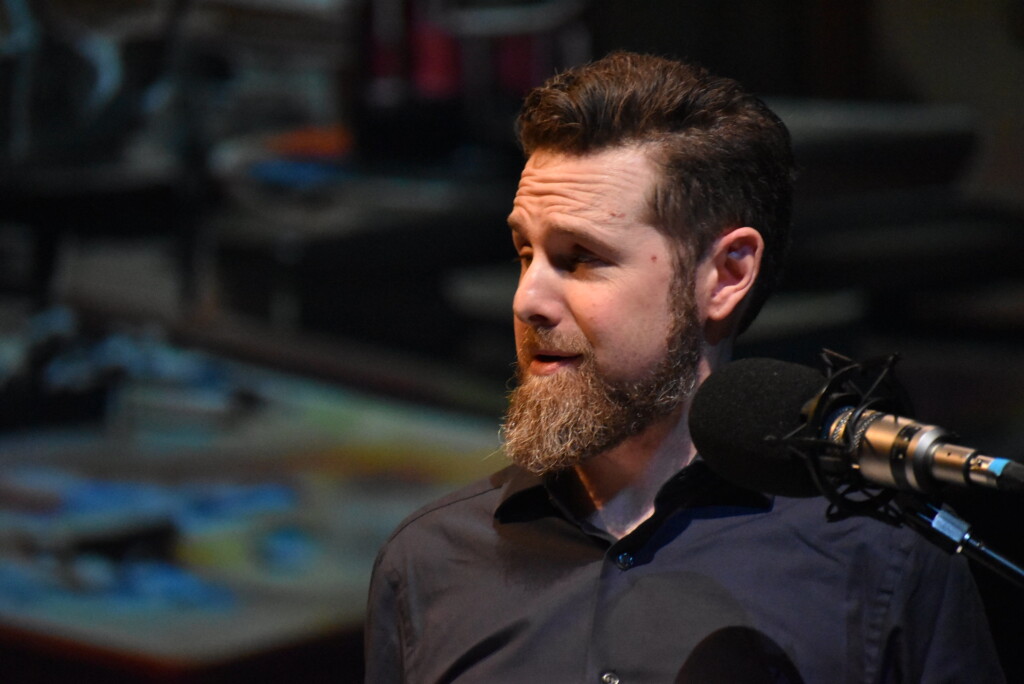
Photo Credit: Sharah Meservy.
11:41 a.m.
Back from the station break and hang on: the concluding portion of this Radio Hour episode will be a race.
In Scene 8, gunfire is exchanged, in battle with the Maitre D’, who is definitely working for Moriarty.
11:43 a.m.
In Scene 9, Holmes worries for Watson’s safety, urging her to return to London. Holmes recovers the earlier encounter with Moriarty: “If I read his character right, he will devote his power to revenge. He said as much in our short interview and I fancy he meant it.”
Watson will have none of it: “I just saved your life. Again.”
11:44 a.m.
In Scene 10, a week has passed, as Holmes and Watson wandered up the Rhone in Switzerland, and then crossed over the Gemmi Pass, which was still deep in snow.
In retrospect, Watson spoke about how Holmes believed that everyone they met surely must have been coordinated by Moriarty.
11:48 a.m.
In Part 3, we hear more of Bennett’s smart, appropriate touches to the original story, which Doyle left open to the reader’s imagination.
As noted in The Utah Review preview: Bennett saw the opportunity for the two principal protagonists to pause and linger, leading to the emotional dialogue that Holmes and Watson have. The script reveals just how deftly Bennett can invoke the archetype of the genius while still humanizing the individual as capable of possessing the hesitations and doubts associated with the quotidian human experience.
HOLMES:
Suppose I do. Suppose your implication, of my alleged lack of interest in women, has not been lost on me. Still, absence of evidence is not evidence of absence.
WATSON:
No, but it is expressive. The absence of all relationships in your life is expressive. I can appreciate that your…identity in personal matters is complicated—
11:49 a.m.
In Scene 11 and in the remaining scenes of this episode, Bennett sets up how the final struggle between Holmes and Moriarty might have materialized at the Reichenbach Falls scene, which is not part of the Doyle original.
There is today a Sherlock Holmes museum in the town of Meiringen as well as a plaque honoring the fictional detective (in German, French, and English) near one of the waterfall overlooks.

Photo Credit: Sharah Meservy.
11:52 a.m.
In retrospect, Watson recalls the Swiss lad messenger who summoned her back to the hotel. The message indicated that one of the English guests had suffered a hemorrhage and was refusing medical attention from a Swiss physician.
Holmes inspected the letter, winked at Watson, and she hurried down the hill. She observed, “a man moved rapidly. I could see his outline clearly against the green. Yet my mind was on my errand.”
11:53 a.m.
In Scene 12, Watson realizes that the message was a ruse, as the hotel manager tells her that it must have been a tall fellow who came in after she left with Holmes.
11:53 a.m.
In Scene 13, Bennett lays out the final battle between Moriarty and Holmes. Watson speaks to the audience: “I cannot know what happened between them, of course, but many a night have I lain sleepless, hearing his voice. And then the other voice.”
11:55 a.m.
Bennett is very good at adaptations and these last scenes are crafted with the utmost appreciation for the original author and the sake of integrity and continuity.
Moriarty tells Holmes that he wants the detective to write a letter to Watson. “I want to read what you write. And then, dear boy, we will see your brains at last. Everywhere.”
11:57 a.m.
Scene 14: the ending to Radio Hour Episode 17: Sherlock Holmes and The Final Problem. In the original, Doyle also includes the final note from Holmes to Watson.
From Bennett’s version:
If I confess fully, I knew the letter from Mr. Steiler was a hoax. I allowed you to leave on your errand knowing I would meet my end here. Tell the Inspector that the papers necessary to convict the gang are in pigeonhole M. I made every disposition of my property and passed it to my brother Mycroft — excepting, of course, my collection of tobacco pipes, which I bequeath to you. Give my regards to “Mr. Watson,” and believe me to be very sincerely yours, Sherlock Holmes.
POSTSCRIPT
As noted in The Utah Review preview, the 1893 story sent Sherlock Holmes fans into shock and mourning, with many following Victorian Era conventions by wearing black armbands and putting up black crepe paper. Doyle had hoped that by killing off Holmes, he could finally gain recognition for his other work. The pushback was so strong that eventually Doyle had to ‘resurrect’ Holmes. Nevertheless, the Holmes literary enterprise has been rock solid and 130 years later, it still inspires contemporary adaptations in fan fiction, theatrical productions, television and film.
Bennett’s adaptation is an excellent example of how the Holmes canon can continue to thrive, as well as inspire and entertain readers and theater goers. The audience which included theater patrons and high school students enjoyed the dry, smart wit in the banter between Watson and Holmes. Reeder demonstrated convincingly the credible assertion of Watson as a female lead. Perry has cultivated a massive catalog of character voices, with all 17 episodes of Radio Hour in his portfolio, and his presence is essential to the thriving success of this signature series. Fabrizio’s interpretation of Holmes, his second take as the fictional detective, is charming and his involvement in the series as a host and as an actor (his sixth role in the series).
The backdrop visuals enhance the vivid dialogue Bennett crafted. Notably, this Radio Hour episode had comparatively fewer sound effects than others. Kudos as well go to David Evanoff for scoring the time-appropriate vibe to go with a story that was written in 1893. Nevertheless, in 2023, this production demonstrates how a set of characters and story lines placed in the middle of the Victorian Era connects in many gratifying ways with either those who know the Sherlock Holmes canon well enough for trivia competitions or for those who might be inspired to read the numerous stories about Holmes after this production. Indeed, in an immersive digital age, radio drama is resilient and relevant.

